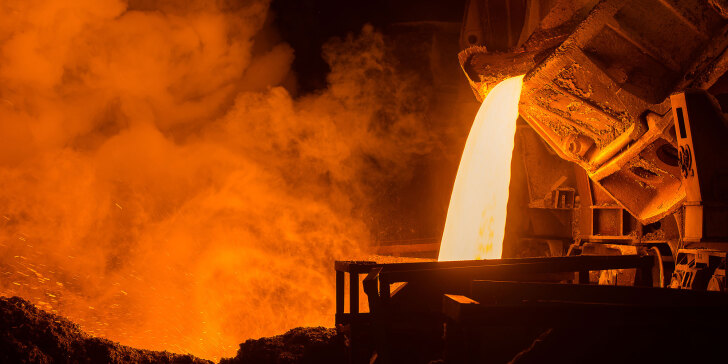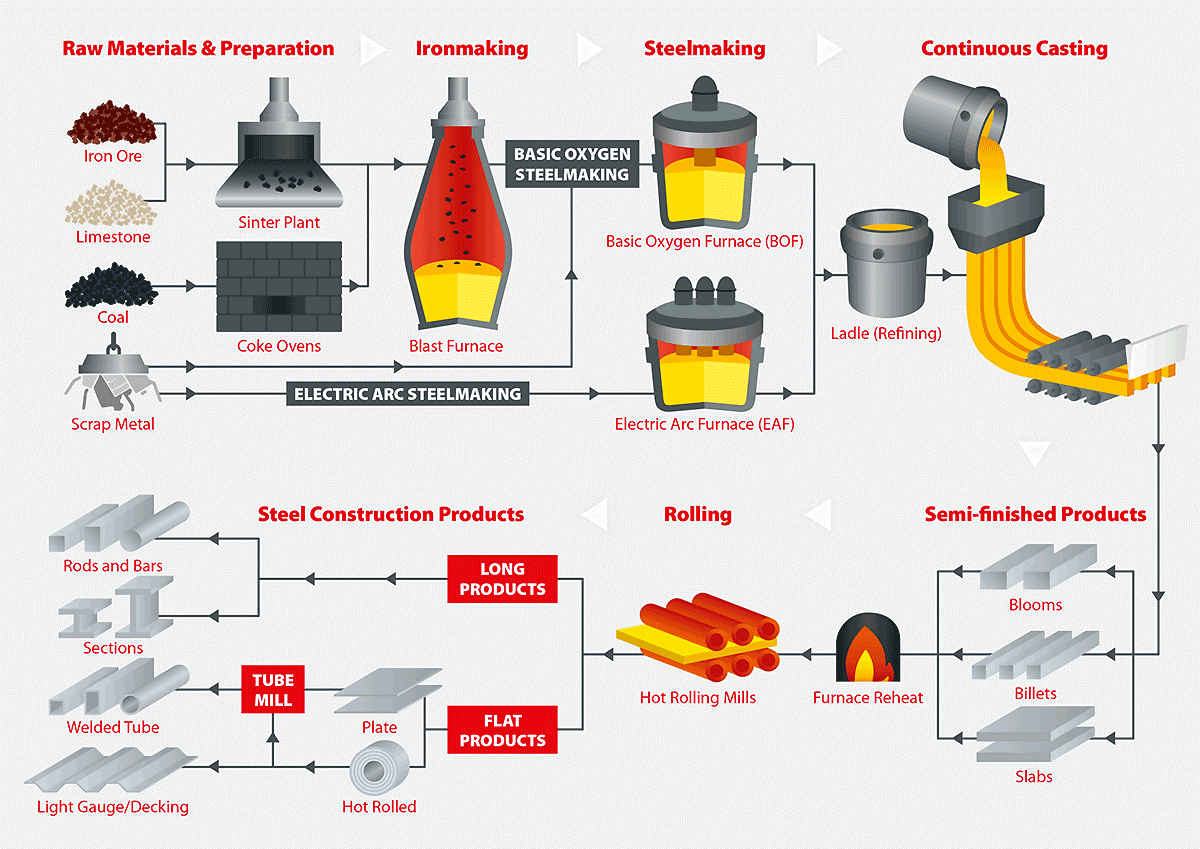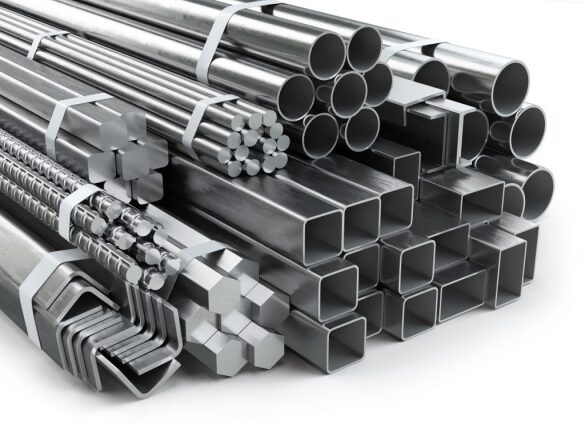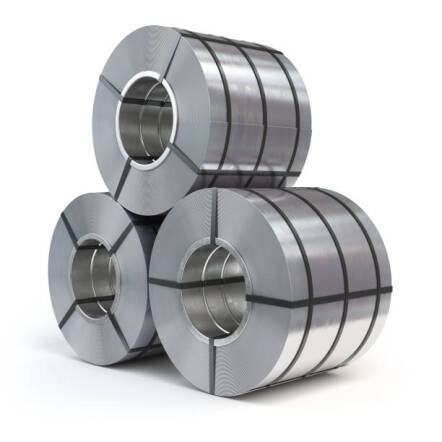Steel Production Chain: From Mining to Final Products

The steel production chain is a fascinating journey from mining to final products that involves a series of intricate processes transforming raw materials into one of the most vital components of modern infrastructure and industry. Steel is a fundamental material, essential in everything from towering skyscrapers and expansive bridges to the cars we drive and the appliances in our homes. Each stage of this production includes chain-mining, beneficiation, smelting, steelmaking, casting, rolling, and finishing requires advanced technology, skilled labor, and meticulous planning.
In this article, we will explore each step in detail, highlighting the technologies and methods used to ensure that the steel produced meets the highest standards of quality and efficiency. Steel production chain from iron ore to functional industrial products can be simply shown with the picture below. Join us as we delve into the remarkable processes that transform simple minerals into the backbone of our modern world.
Mining Process
The journey of steel begins with the extraction of iron ore from the earth. Iron ore is a mineral substance from which iron (Fe) can be economically extracted. It is typically found in the form of magnetite (Fe3O4), hematite (Fe2O3), goethite, limonite or siderite. These minerals contain iron and are used as sources of iron ore for the production of steel. The quality of the iron ore, its size and concentration determine its suitability for steel production. The techniques used in the modern mining and extraction of the minerals do not endanger the existence of the resources but rather enhance the extraction of all the resources to their fullest.
Iron ore mining process involves several stages, including exploration, drilling, blasting, and hauling. Initially, geologists conduct surveys and use various techniques, including satellite imagery and ground-based methods to locate potential ore deposits. In the exploration phase detailed geological studies are conducted to determine the size, shape, orientation, and quality of the ore body. This phase often includes geophysical methods such as magnetic, seismic, and electrical resistivity surveys, which help in delineating the ore deposits accurately. Once an ore body is identified, development activities commence. This includes removing vegetation and overburden in surface mining which is crucial as it involves removing large amounts of overburden to access the ore beneath. For underground mining, creation of access shafts and developing coherent tunnels does provide an assurance to the miners to safely and efficiently obtain the deeper ores located within the ground.
Drilling and blasting techniques are then employed to fragment the ore body into smaller, manageable pieces. High-precision drilling machines create deep holes in the earth, which are filled with explosives. Controlled explosions fracture the ore, making extraction easier. The broken ore is subsequently loaded onto trucks or conveyors for transportation to a processing facility. This stage entails a lot of planning as regards to transportation of the ore in order to minimize on the costs of transport as much as possible.
Beneficiation Process
Following extraction and transportation to the processing plant, the mineral undergoes beneficiation aimed at enhancing its iron content while removing impurities. This multifaceted process includes several key steps such as crushing, grinding, magnetic separation, flotation, and occasionally chemical treatment.
Initially, the raw ore is crushed into smaller fragments and subsequently ground into a fine powder to liberate iron particles from the surrounding matrix. Magnetic separators are then employed to segregate iron-rich particles from the gangue (waste material), thereby facilitating the concentration of valuable iron ore. Further refining may involve flotation techniques to eliminate impurities like silica and phosphorus, enhancing the ore's quality and market value (Check our article titled "A Deep Dive into Mineral Processing Equipment").
Smelting Process
The next stage in the steel production chain is smelting, a process where iron ore is transformed into molten iron. Typically conducted in a blast furnace, which is a large, cylindrical furnace lined with refractory bricks. This method involves several sequential operations designed to efficiently convert raw materials into usable metal and involves the following steps:
1. Charging
At the onset of the smelting process, the following raw materials are simultaneously charged; Iron ore, coke (which is mainly sourced from coal), and limestone is introduced into the top of the blast furnace. The charging phase is very essential as it creates the required environment for the series of reactions in the reduction of iron. It is also widely used as the chief input, which provides the iron oxide required for the reduction process. Coke, acting as both a fuel source and a reducing agent, reacts with oxygen to generate carbon monoxide within the furnace.

2. Combustion
At the same time, hot air from the burner is blown at high pressure into the lower part of the furnace. This oxygen-rich airflow is supplied to coke in the form of airflow which causes the start of combustion and results into carbon monoxide (CO). The CO gas thus acts as the reducing agent by reacting with the iron ore to produce molten iron. This reduction process is basic because it releases metallic iron after the extraction of iron from its oxide state.
3. Formation of Slag
During the smelting operation, limestone (calcium carbonate or CaCO3) added to the furnace reacts with silica-bearing impurities in the iron ore. This chemical reaction generates calcium silicate, a byproduct known as slag. This slag which is less dense than the molten iron, floats on the metal and is therefore easily skimmed off from the molten iron when the process is complete.
4. Tapping
Periodically, the molten iron, which is known as pig iron owing to its higher carbon percentage, is tapped from the base of the blast furnace. This tapping process is well coordinated so as to maintain constant working and allow for accumulation of molten metal to feed the next processes of refining and casting as may be required.
WE ARE KIMIA
Kimia Holding stands as a diversified conglomerate with a strong foothold in various sectors including mining and mineral resources, tourism services, livestock and poultry, agriculture, and foreign trade foreign trade in Iran and across the Middle East. However, it is within the realm of mining that Kimia Holding has truly distinguished itself, garnering recognition for its unwavering commitment to excellence and innovation.
CONTACT KIMIA
Our experts at Kimia Holding eagerly await your inquiries and are prepared to provide insightful answers or address any questions you may have. Should you require further details or wish to share your opinions, please don't hesitate to reach out. Your engagement is valuable to us.
1. BOF
The next step in the steel production chain is converting pig iron into steel. There are two primary methods for steelmaking: Basic Oxygen Furnace (BOF) and Electric Arc Furnace (EAF).
Primary Steelmaking
Secondary Steelmaking

Applications of Steel in Industries
Steel is a fundamental material in modern industry, renowned for its versatility, strength, and durability. It is extensively used across various sectors due to its exceptional properties. In the construction industry, steel is vital for building infrastructure, including skyscrapers, bridges, and residential buildings, owing to its high tensile strength and resistance to environmental factors. The automotive industry relies on steel for manufacturing vehicle bodies, engines, and various components, benefiting from its crash resistance and cost-effectiveness. In the energy sector, steel is indispensable for constructing pipelines, oil rigs, and power plants, as it can withstand extreme pressures and temperatures. Additionally, the machinery and equipment industry utilize steel to produce industrial machines, tools, and appliances, ensuring longevity and reliability.
Steel also plays a critical role in the ship building industry, where its high strength and durability are essential for constructing ships and submarines that will be used in rough seas. In the medical field, steel is used to manufacture surgical tools, implants and different health related instruments because of the biocompatibility of steel and it is also easy to sterilize. The aerospace industry benefits from steel's ability to maintain structural integrity under high stress, making it suitable for aircraft frames and engine components. Also, household items such as kitchen utensils, appliances, and furniture often incorporate steel, highlighting its widespread use in daily life. The fact that the steel material can be recycled, enhances its materiality to supporting environmental conservation campaigns and the reduction of wastes.
Conclusion
Steel is a fundamental material in modern industry, renowned for its versatility, strength, and durability. Steel making, the transformation of a raw material into a fully-fledged product involves a chain of operations which are very essential in determining the quality and usefulness of this vital material. Steel's unmatched properties of strength, durability, and versatility make it a cornerstone of various industries, from construction and automotive to energy and medical fields. It is also important to note that steel is fully recyclable, thus making it to serve as a major component in some environmental management agendas. Through the knowledge of the various steps that are involved in the creation of steel, people can realize and admire the ingenuity of engineering and technological advancements that leads to transforming some basic elements into the support of modern society infrastructure and economy. Such steps are inspiring the constant development and evolution of these processes; thus, steel will remain the basis for the advancement of countless industries and aspects of everyday life.
Resources
1. Rosenqvist, T.; Principles of Extractive Metallurgy, McGraw-Hill, 1983.
2. Ghosh, A.; Chatterjee, A.; Ironmaking and Steelmaking: Theory and Practice, Prentice-Hall of India Pvt.Ltd, 2008.
3. Winston Revie, R.; Uhlig's Corrosion Handbook, Wiley, 2011.
4. World Steel Association; "Steel in the circular economy: A life cycle perspective", Worldsteel, 2015.
5. Cameron, I.; Sukhram, M.; Lefebvre, K.; Davenport, W.; Blast Furnace Ironmaking: Analysis, Control, and Optimization, Elsevier, 2019.
6. Salman Abdou, D. M.; Elsherbini, R. N.; Elgayar, M. S.; Shoukry, A.; "Gaining Insights into Rebar Steel Market Forces: Case Study of Ezz Rebar Steel Industry", Economics & Law, 5(2), pp. 99-112, 2023.
The Basic Oxygen Furnace stands as a cornerstone of modern steelmaking, playing a crucial role in transforming pig iron into high-quality steel through a refining process. Widely adopted globally for its efficiency and capacity to produce large quantities of high quality steel economically, the BOF method is pivotal in meeting diverse industrial demands. The several key steps of BOF process are:
1-2. Oxygen Blowing: In the oxygen blowing stage, the high-purity oxygen is blown into the molten iron bath at supersonic velocities. This oxygen then reduces heat exothermically with the carbon and other impurities that are dissolved in the molten metal which in turn got oxidized. Carbon, primarily in the form of carbon monoxide, is immediately burnt to carbon dioxide thus lowering the carbon-equivalent of the molten metal to the required level. Furthermore, other elements such as silicon, manganese and phosphorus are also oxidized and carried away in the form of slags.
1-1. Charging: First, molten pig iron in large amount which is obtained from blast furnaces or direct reduction processes is charged into BOF vessel together with scrap steel. The addition of scrap steel is useful for controlling final composition and also contributes to energy savings and environmental sustainability by recycling metal scrap.
1-3. Tapping: In this stage, the molten steel which is low in carbon and free from other incursions, is tapped from the bottom of the BOF vessel. This molten steel is then subjected to other secondary refining methods, if required, or it goes to the casting processes where the steel is formed into semi-finished or finished products as per the market needs.
2. EAF
An Electric Arc Furnace represents a pivotal technology in steelmaking, utilizing electrical energy to melt scrap steel or direct reduced iron (DRI) and produce a diverse range of steel grades. This method is renowned for its flexibility, efficiency and ability to rapidly adapt to varying steel compositions and market demands, thereby playing a crucial role in the contemporary steel industry. The several key steps of EAF process are:
2-1. Charging: The EAF process starts with the charging of scrap steel into the furnace. Manufacturing scrap and end-of-life products are used as raw material in which scrap steel forms the basis of the company’s inputs. The composition and quality of the scrap steel influence the final steel product's characteristics and properties.
2-2. Melting: Graphite electrodes situated above the scrap charge, conduct electric arcs when electric current is passed through them. These electric arcs develop a very high temperature, exceeding 3000°C (5400°F) or more and turns the scrap steel in to a molten mass in the EAF. The molten steel pool forms at the bottom of the furnace, facilitating efficient mixing and homogenization of the metal.
2-3. Refining: During the refining stage, fluxes such as limestone and dolomite are added to the molten steel bath. These fluxes have various uses, one of which is to purging the steel from any impurities such as sulfur and or phosphorus via a process known as chemical reactions and the other is to alter the composition of the steel to be of a certain quality and or to fit the needs of the costumer of the steel product.
2-4. Tapping: Upon completion of the melting and refining processes, the refined molten steel is tapped from the EAF furnace. This molten steel is then made to undergo secondary refining if required, or it is directly taken to the continuous casting processes where they are cast into semi-finished or finished form as per its application in the downstream industries.
Secondary steelmaking which includes methods such as ladle refining is very crucial in the improvement of the quality of molten steel with regards to primary steelmaking.
It involves refining the steel's chemical composition, removing impurities, and adjusting temperature in a ladle before casting. These steps make sure that the steel that is produced has the correct demands of quality to its mechanical properties and the capacity of performing different functions.
Ladle refining plays a crucial role in modern steelmaking, serving to enhance the quality of molten steel following its production in primary steelmaking furnaces. This refining process takes place within a ladle, a large vessel lined with refractory materials that can withstand the high temperatures of molten steel. The primary objectives of ladle refining include adjusting the chemical composition, removing impurities and controlling the temperature of the steel to achieve desired mechanical and metallurgical properties. Ladle refining can improve steel quality and also has the flexibility advantage. This process significantly improves the cleanliness and homogeneity of the steel. Thus, as a result of the removal of such undesirable elements as sulfur, phosphorus, and non-metallic inclusions, the ladle refining improves the mechanical characteristics and performance characteristics of the steel. This results in steel products with superior toughness, ductility, and fatigue resistance. Ladle refining also consists of the advantage of being able to control the chemical composition and heat of the steel quite effectively. This flexibility makes it possible for the steel producers to adjust the characteristics of the steel to the customer expectations and application needs. Moreover, through ladle refining, it is possible to control alloying additions and deoxidizers with the required specifics of steel composition for subsequent stages of production.
Casting
Following ladle refining, the next critical step in the steel production chain is casting, where the refined molten steel is solidified into semi-finished forms such as billets, blooms or slabs. This process involves carefully controlling the cooling rate to achieve the desired microstructure and mechanical properties of the final steel product.
Rolling
Rolling is performed at room temperature to obtain the required surface finish and precise dimensional tolerances. Its main application is in the increase and improvement of mechanical characteristics of steel, more specifically, the smoothness and uniformity. It is a process through which thinning is done to hot-rolled steel at the normal temperature through the use of rollers which stretch and thins through the pressure exerted to make the material to become stronger and harder. The resulting products exhibit superior surface quality, tight thickness tolerances and enhanced mechanical properties compared to their hot-rolled counterparts. Cold-rolled steel is thus very acceptable for those applications that need very smooth surface and accurate dimensions. Rolling is an important process in making steel sheets, rods, sections, welded tubes, light gauge, strips and coils used in the related industries.
Coating and Surface Treatment
The final stage of the steel production chain involves coating and surface treatments aimed at enhancing the steel's properties and aesthetic appeal which can be classified as follows. These treatments are very vital in making sure that the steel products produced will be able to deliver certain performances in various fields such as construction and infrastructure industries, automobile and consumer goods.
Galvanizing: Steel undergoes a process where it is coated with a layer of zinc to enhance its corrosion resistance. This method is termed as the process of galvanization since it acts as an insulate the steel substrate from the working environment hence increasing the service of the steel in its numerous uses.
Painting: Steel surfaces are often painted to provide protection against environmental elements such as moisture and UV radiation. Furthermore, painting enhances the steel's appearance, making it suitable for architectural applications, the automobile industry and the industrial sector where design forms part of the consumer products.
Plating: Another method involves coating steel with metals like chromium, nickel, or tin through electroplating or other techniques. These metallic coatings improve surface hardness, corrosion resistance, and wear resistance, making the steel suitable for applications requiring durability and aesthetic appeal.

Written by Folad Kavan Company (FKC)
which holds a central position in driving the development of the regional steel production chain. The construction of its pellet factory began in late 2022, covering a vast expanse of 15 hectares and involving a collaborative effort between domestic and foreign companies. Currently, critical infrastructure, including gas, electricity, telecommunication systems, and water supply, is actively being established. This highlights the company's steadfast commitment to enhancing steel production capabilities and supporting the local economy in the region.





